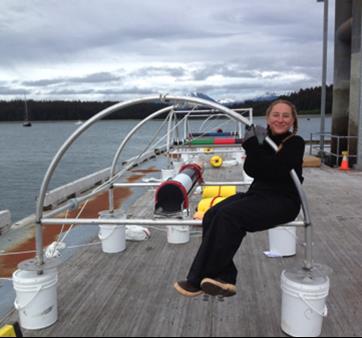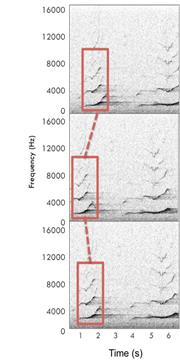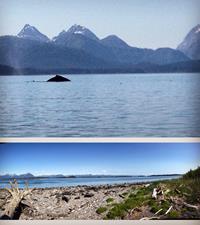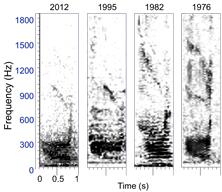Media Included
- Whups and Roars of Glacier Bay - Explore the underwater acoustics of humpback whales and harbor seals.
How often do humpback whales vocalize and how loudly? Do humpback whales communicate differently when vessels are around?
Project Dates
May 2015—October 2016
Did You Know?
In addition to singing long elaborate songs, humpback whales in Southeast Alaska produce at least sixteen unique vocalizations known as non-song calls or ‘social calls’. Unlike song, which changes every year, humpback whales have been producing some of these calls in Southeast Alaska for decades.
Introduction

Nearly all visitors to Glacier Bay arrive via motor vessels, yet the impact of the associated engine noise on humpback whale communication is unknown. Over the past 35 years extensive research on underwater sound has been conducted in Glacier Bay National Park and Preserve. There is a high density of acoustically oriented marine mammals in Glacier Bay, including humpback whales, which rely on sound to communicate, forage, and interact with their environment. Humpback whales have been the subject of decades of dedicated research in Glacier Bay, resulting in a wealth of highly detailed information about individuals and their life histories. In this study PhD student Michelle Fournet hopes to pair this legacy of acoustic research with what is known about Glacier Bay’s humpback whales to understand more about how these animals are using the acoustic environment, and how they may be altering their vocal behavior in the response to vessel noise.
Humpback whales produce a wide variety of calls in Southeast Alaska. While the exact function of each vocalization is unknown, some of these calls are believed to facilitate social interactions and other may be linked to foraging behavior. What researchers in this study hope to find out is how loud these calls are, how often individual humpback whales are producing them, and if humpback whales are adapting their call volume or call rates when vessel noise inundates the underwater environment.
Additionally, by pairing underwater recordings of humpback whales with land-based visual observations and photo identification, researchers may be able to glean information into who is producing these calls and what the potential role of these vocalizations may be. By investigating the social calls produced underwater, researchers can get a more detailed picture of what role vocalizations play in humpback whale daily life.
Because vessel traffic in Glacier Bay is regulated, ‘noisy’ periods (periods of comparatively high vessel noise) are punctuated with periods of relative ‘quiet’ (low vessel noise). The behavior of the whales in these contrasting states can be compared to investigate how humpback whales adapt their vocal behavior in response to vessel noise.
Methods

In May 2015 four autonomous underwater hydrophones (AUHs) were deployed on the east side of Strawberry Island in the Beardslee Island Complex. The four hydrophones (underwater microphones) will record continuously until October 2015 and will be re-deployed for the summer of 2016. By having four hydrophones researchers can acoustically localize calling whales underwater, which enables them to calculate how loud each call may be and where the call was produced. Using this information calling whales can be ‘tracked’ underwater; their calls can be classified, described, and calling rates can be calculated. Understanding how loud a call is gives managers and scientists information on how likely these calls are to be detected when the environment gets noisy. Understanding how often they are calling provides clues into why the calls are produced, and how humpback whales may adapt to future changes.
In summers of 2015 and 2016, a small team of researchers will observe whales from a shore station located on Strawberry Island. The team will use a theodolite (a.k.a. surveyors transit) and a high-powered spotting scope to track the behavior of animals at the water’s surface and to photograph them for individual identification. By pairing the visually observed locations and behaviors and the location of calling whales observed acoustically, we can get a more detailed picture of what role vocalizations play in humpback whale daily life.
Because vessel traffic in Glacier Bay is regulated, ‘noisy’ periods (periods of comparatively high vessel noise) are punctuated with periods of relative ‘quiet’ (low vessel noise). The behavior of the whales in these contrasting states can be compared to investigate how humpback whales adapt their vocal behavior in response to vessel noise.

Findings

The hydrophones deployed in the Beardslee Island complex began recording at midnight on May 28th, 2015 and have since accumulated hundreds of hours of underwater sounds. The recordings of this underwater soundscape will be analyzed starting in October 2015 when the hydrophones will be retrieved. At that time, researchers will listen and localize whale calls that were produced over the summer and pair these acoustic observations with visual observations that from Strawberry Island. Until then, the researchers on this project will be collecting field data in Glacier Bay and anxiously awaiting instrument recovery in the fall.
Learn More
Glacier Bay Research: https://www.nps.gov/glba/learn/scienceresearch.htm
Humpback whales in Glacier Bay: https://www.nps.gov/glba/learn/nature/seal.htm
ORCAA’s Research: http://bioacoustics.oregonstate.edu
Last updated: September 28, 2016
